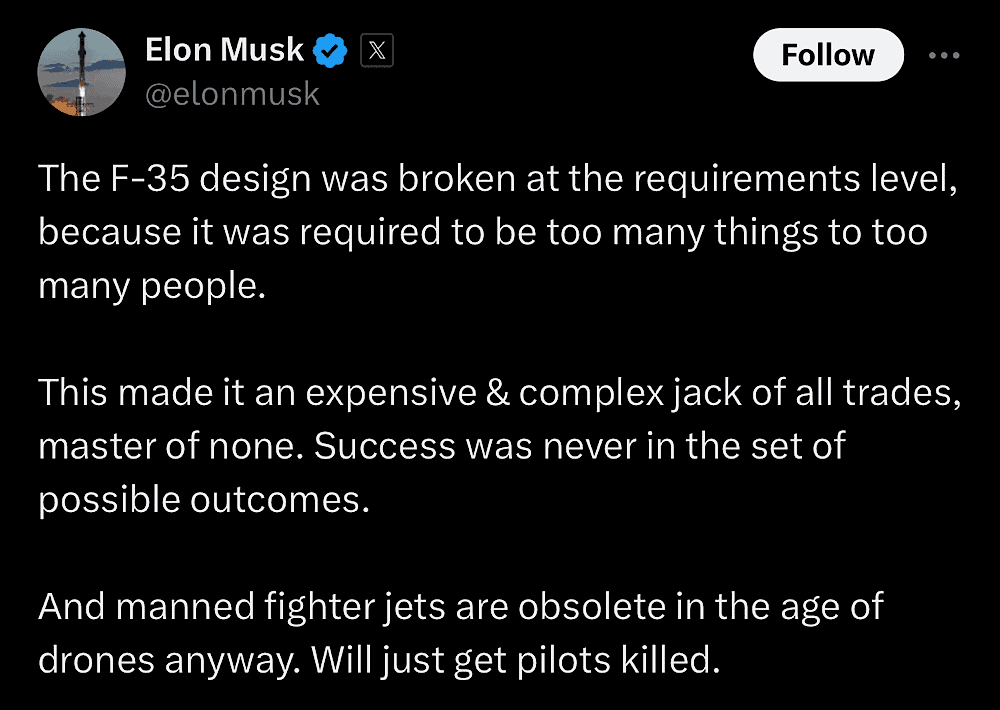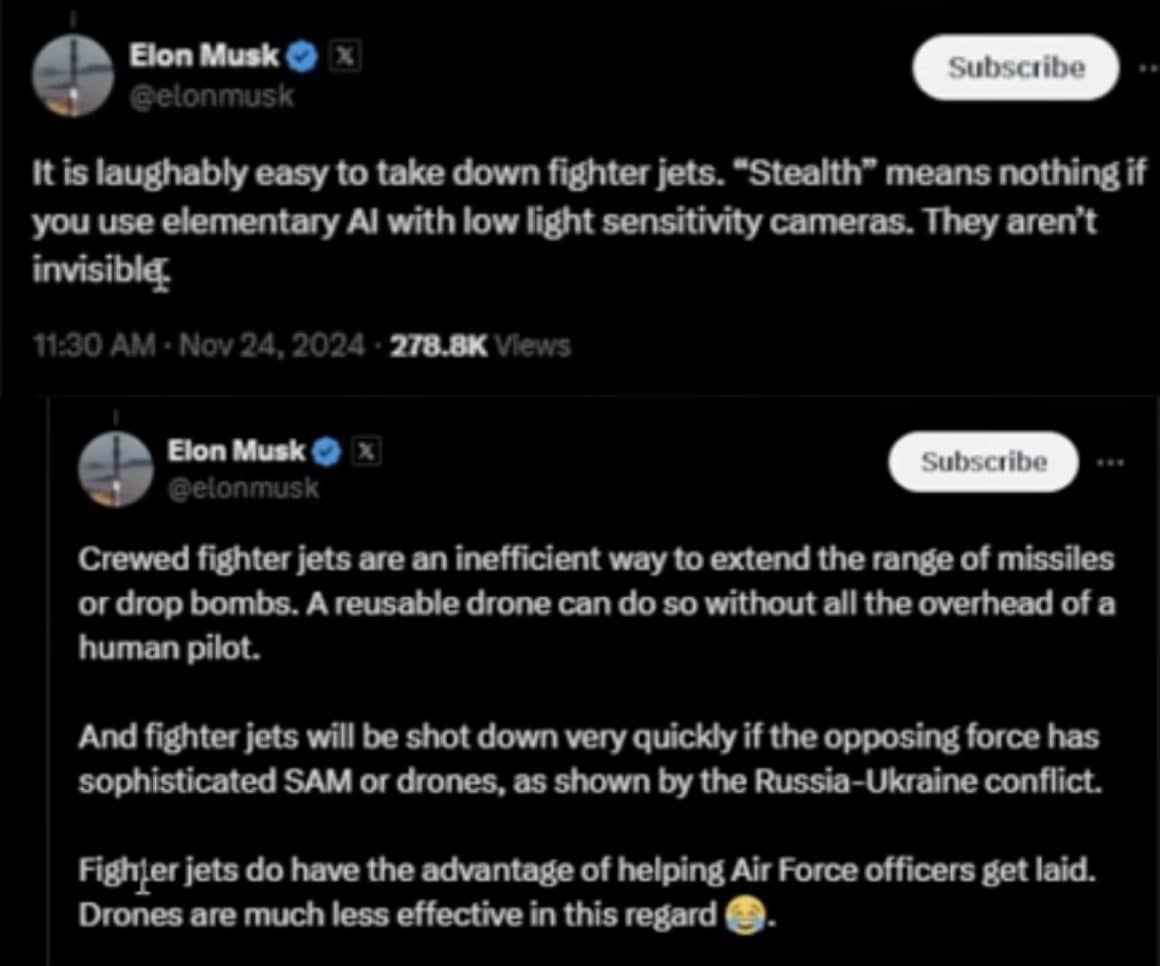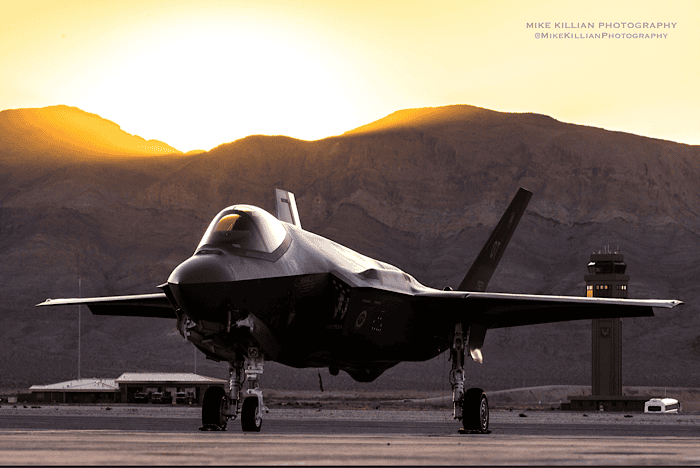Elon Musk has attacked many organizations over the last decade that he believes waste billions of taxpayer dollars. This week, his attacks turned to the F-35 program, even saying all jets requiring pilots in jets are now obsolete and only still exist to help them get laid.
It’s no secret the F-35 program is far from perfect. It’s $180 billion over budget and has been plagued with delays and technical issues, and some have even crashed.

Declassified Pentagon report cites numerous problems, even though the jet has been flying for 18 years
A recently released declassified Pentagon report on the F-35 program noted many ongoing problems. They include guns that don’t shoot straight, stealth skin that doesn’t stay on, cybersecurity concerns and maintenance problems, among others. Even after flying for nearly 20 years.
Some more of Musk’s comments on his X platform below. He sees remotely-controlled aircraft and drones as the future, for far less money and risk.

Musk’s comments matter, because he is set to lead the newly created Department of Government Efficiency, advising President Trump and the White House on slashing federal waste and spending.
Question is, is this just rhetoric from Musk? Or will a Trump administration take action on his recommendations? Trump has previously said it’s the best jet in the world, but even during his last campaign for President raised questions about costs. He even wants all the manufacturing done in America, rather than different parts being made overseas and assembled in America.

Musk has a track record of going after established legacy contractors, and winning
It’s no secret to voters and taxpayers that many federal programs are just money-grabs for long-established legacy contractors. Musk has a track record of going after those contractors, and winning. Or, at least changing the game.
In the space industry, his primary attacks were against United Launch Alliance (ULA). The launch company is a merger between Boeing and Lockheed, and basically had a monopoly to launch payloads for the DOD and NASA.

He not only attacked ULA for ripping taxpayers off, but also created a PR nightmare for them for using Russian engines on the Atlas V rocket to launch national security missions. Musk also attacked politicians who allowed all of it, including those who made it difficult for SpaceX to compete for those contracts.
That attack worked, forcing ULA to restructure and even make a new rocket with American-made engines to compete with SpaceX and the incoming Blue Origin. Taxpayers heard Musk and demanded better of the elected officials in bed with ULA, to allow SpaceX to compete against them.
Lockheed, the Pentagon, and pilots of the F-35 absolutely love the fighter

Officially, the Air Force and Pentagon paint the F-35 as exactly what they wanted. A lethal allied command-and-control platform killer or defender that will strike the adversary down at distance, without the victim even knowing the F-35 was there.
There’s no doubt the F-35 gets the job done, even having a 20:1 kill ratio in realistic training and simulations. Simply put, the software-driven jet will obliterate any adversary aircraft beyond visual range. if the adversary can get within visual range, it becomes an old school dogfight, which is what the F-35 wants to avoid in the first place.
”We have combat capable aircraft in operation today and they perform exceptionally well against the threat for which they were designed,” says the Pentagon’s F-35 program office. “Pilots continually emphasize that this is the fighter they want to take to war if called upon.”
Lockheed says the jet is consistently meeting and exceeding the reliability performance requirements they are contracted to deliver, with nearly 90% of F-35 components performing better than required.

The total cost over the life of the F-35 program is estimated to be $1.8 trillion, according to the DOD’s Cost Assessment and Program Evaluation. The majority of the cost – $1.27 trillion – isn’t for the cost of buying the jets, but the costs to keep them flying. The US government wants them operational into the 2080s.
Currently, Lockheed plans to produce 2,500-3,000 F-35s, at over $80 million a piece. So far, 1,000 have been delivered to the US Navy, Air Force, and Marines, as well as allied nations.
